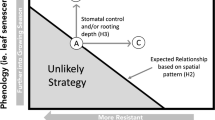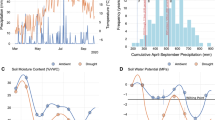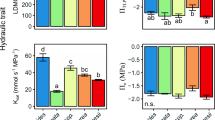Abstract
The alien grass, Pennisetum setaceum, dominates many of the lowland arid regions that once supported native Heteropogon contortus grassland on the island of Hawaii. Response to drought in a glasshouse was compared between these C4 grasses to test if success as an invader is related to drought tolerance or plasticity for traits that confer drought tolerance. Pennisetum produced 51% more total biomass, allocated 49% more biomass to leaves, and had higher net photosynthetic rates (P n) on a leaf area basis than Heteropogon. Plants of both species under drought produced less total biomass and increased their allocation to roots compared to well-watered plants, but there was no difference between the two species in the magnitude of these responses. The decline in P n with decreasing leaf water potential (ψ1) was greater for Pennisetum compared to Heteropogon. Plasticity in the response of P n to ψ1, osmotic potentials, and the water potentials at turgor loss in response to drought were not different between the two species. Stomata were more responsive to Δw in Heteropogon than in Pennisetum and for well-watered plants compared to droughted plants. Plasticity for the stomatal response to Δw, however, was not different between the species. There was no evidence that the alien, Pennisetum, had greater plasticity for traits related to drought tolerance compared to the native, Heteropogon. Higher P n and greater biomass allocation to leaves resulted in greater growth for Pennisetum compared to Heteropogon and may explain the success of Pennisetum as an invader of lowland arid zones on Hawaii.
Similar content being viewed by others
References
Atlas of Hawaii 2nd edn. (1983) Department of Geography, University of Hawaii, University of Hawaii Press, Honolulu
Baker HG (1974) The evolution of weeds. Annu Rev Ecol Syst 5:1–24
Baker HG (1986) Patterns of plant invasion in North America. in Mooney HA, Drake JA (eds) Ecology of biological invasions of North Americal and Hawaii (Ecological Studies 58). Springer, New York, pp 44–57
Barrett SCH, Richardson BJ (1986) Genetic attributes of invading species. In Groves RH, Burdon JJ (eds) Ecology of biological invasions. Academy of Science, Canberra, pp 21–33
Baruch Z, Ludlow MM, Davis R (1985) Photosynthetic responses of native and introduced grasses from Venezuelan savannas. Oecologia 67:388–393
Bazzaz FA (1979) The physiological ecology of plant succession. Annu Rev Ecol Syst 10:351–371
Bazzaz FA (1986) Life history of colonizIng plants: some demographic, genetic, and physiological features. In Mooney HA, Drake JA (eds) Ecology of biological Invasions of North America and Hawaii (Ecological Studies 58). Springer, New York, pp 96–110
Bingham GE, Coyne PI, Kennedy RB, Jackson WL (1980) Design and fabrication of a minicuvette system for measuring leaf photosynthesis and stomatal conductance under controlled conditions. Lawrence Livermore Laboratory, University of California, Lawrence, California
Black RA, Richards JH, Manwaring JL (1994) Nutrient uptake from enriched soil microsites for three Great Basin perennials. Ecology 75:110–122
Caldwell MM, Richards JH, Johnson DA, Nowak RS, Dzurec RS (1981) Coping with herbivory: photosynthetic capacity and resource allocation in two semiarid Agropyron bunchgrasses. Oecologia 50:14–24
Chaves MM (1990) Effects of water deficits on carbon assimilation. J Exp Bot 42:1–16
Cuddihy LW (1989) Vegetation zones of the Hawaiian islands. In Stone CP, Stone DB (eds) Conservation biology in Hawaii. University of Hawaii Press, Honolulu, pp 27–35
Cuddihy LW, Stone CP (1990) Alteration of native Hawaiian vegetation. University of Hawaii Press, Honolulu
Degener O, Degener I (1968) Flora Hawaiiensis, Fam. 47, Heteropogon contortus. Published privately, Honolulu, Hawaii, USA
Evans RD, Black RA, Link SO (1990) Rehydration-induced changes in pressure-volume relationships of Artemisia tridentata Nut. spp. tridentata. Plant Cell Environ 13:455–461
Freund RJ, Littell RC, Spector PC (1986) SAS system for linear models. SAS Institute, Cary, North Carolina
Gollen T, Turner NC, Schulze E-D (1985) The responses of stomata and leaf gas exchange to vapour pressure deficits and soil water content III. In the sclerophyllous woody species Nerium oleander. Oecologia 65:356–362
Gray AJ (1986) Do invading species have definable genetic characteristics? Phil Trans R Soc London B 314:655–674
Groves RH (1986) Plant invasions of Australia: an overview. In Groves RH, Burdon JJ (eds) Ecology of biological invasions. Cambridge University Press, Cambridge, pp 137–149
Hall AE, Schulze E-D, Lange OL (1976) Current perspectives of steady state stomatal responses to environment. In: Lange OL, Kappen L, Schulze E-D, (eds) Water and plant life. (Ecological Studies 19). Springer, Berlin Heidelberg New York pp 169–188
Harper, JL (1977) The population biology of plants. Academic Press, New York
Heywood VH (1989) Patterns, extents and modes of invasions by terrestrial plants. In: Drake JA, Mooney HA, Castri F di, Groves RH, Kruger FJ, Rejmanek M, Williamson M (eds) Biological invasions: a global perspective. (SCOPE series 37). John Wiley and Sons, New York, pp 31–60
Hitchcock, AS (1950) Manual of the grasses of the United States (Miscellaneous Publication 200). United States Department of Agriculture, Washington, DC, USA
Jarvis, PG (1980) Stomatal response to water stress in conifers. In: Turner NC, Kramer PJ (eds) Adaptation of plants to water and high temperature stress. John Wiley and Sons, New York, pp 105–122
Losch R, Tenhunen JD (1981) Stomatal responses to humidityphenomenon and mechanism In: Jarvis PG, Mansfield TA (eds) Stomatal physiology, Cambridge University Press, Cambridge, pp 137–161
Ludlow MM, Chu ACP, Clements RJ, Kerslake RG (1983) Adaptation of species of Centrosema to water stress. Aust J Plant Physiol 10:119–130
Ludlow MM, Fisher MJ, Wilson JR (1985) Stomatal adjustment to water deficits in three tropical grasses and a tropical legume grown in controlled conditions and in the field. Aust J Plant Physiol 12:131–149
Mack RN (1985) Invading plants: their potential contribution to population biology. In White J (ed) Studies on plant demography: a festschrift for John L. Harper. Academic Press, London, pp 127–142
Mack RN (1989) Temperate grasslands vulnerable to plant invasions: characteristics and consequences. In Drake JA, Mooney HA, Castri F di, Groves RH, Kruger FJ, Rejmanek M, Williamson M (eds) biological invasions: a global perspective. (SCOPE series 37), John Wiley and Sons, New York, pp 155–180
Mack RN, Pyke DA (1983) The demography of Bromus tectorum L.: variation in time and space. J Ecol 71:69–93
Meinzer FC, Grantz DA, Goldstein G, Saliendra NZ (1990) Leaf water relations and maintenance of gas exchange in coffee cultivars grown in drying soil. Plant Physiol 94:1781–1787
Newsome AE, Noble IR (1986) Ecological and physiological characters of invading species. In Groves RH, Burdon JJ (eds) Ecology of biological invasions. Cambridge University Press, Cambridge, pp 1–20
Parsons JJ (1972) Spread of African pasture grasses to the American tropics. J Range Manage 25:12–17
Pavlik M (1983) Nutrient and productivity relations of the dune grasses Ammophila arenaria and Elymus mollis II. Growth and patterns of dry matter and nitrogen allocation as influenced by nitrogen supply. Oecologia 57:233–238
Pierce M, Raschke K (1980) Correlation between loss of turgor and accumulation of abscisic acid in detached leaves. Planta 148:174–182
Robichaux RH (1984) Variation in the tissue water relations of two sympatric Hawaiian Dubautia species and their natural hybrid. Oecologia 65:75–81
Saliendra NZ, Meinzer FC (1991) Symplast volume, turgor, stomatal conductance and growth in relation to osmotic and elastic adjustment in droughted sugarcane. J Exp Bot 42:1251–1259
Schulte PJ, Hinckley TM (1985) A comparison of pressure-volume curve data analysis techniques. J Exp Bot 36:1590–1602
Schulze E-D, Hall AE (1982) Stomatal responses, water loss and CO2 assimilation rates of plants in contrasting environments. In: Lange OL, Nobel PS, Osmond CB, Zeigler H (eds) Physilogical plant ecology II. Water relations and carbon assimilation. (Encyclopedia of Plant Physiology 12B). Springer, Berlin, pp 181–230
Tothill JC (1968) Variation and apomixis in Heteropogon contortus, Gramineae. Bol Soc Argent Bot 12:188–201
Turner NC (1986) Adaptation to water deficits: a changing perspective. Aust J Plant Phys 13:175–190
Turner NC, Jones MM (1980) Turgor maintenance by osmotic adjustment: a review and evaluation. In Turner NC, Kramer PJ (eds) Adaptation of plants to water and high temperature stress. John Wiley and Sons, New York, pp 89–103
Turner NC, Schulze E-D, Gollan T (1984) The responses of stomata and leaf gas exchange to vapour pressure deficits and soil water content. I. Species comparisons at high soil water content. Oecologia 63:338–342
Wagner WL, Herbst DR, Sohmer SH (1990) Manual of the flowering plants of Hawaii University of Hawaii Press, Honolulu
Williams DG (1992) Physiological ecology of the invasive grass Pennisetum setaceum on Hawaii. Ph.D. Dissertation, Washington State University, Pullman Washington, USA
Williams DG, Black RA (1993) Phenotypic variation in contrasting temperature environments: growth and photosynthesis in Pennisetum setaceum from different altitudes on Hawaii. Funct Ecol 7:623–633
Wilson JR, Ludlow MM, Fisher MJ, and Schulze E-D (1980) Adaptation to water stress of the leaf water relations of four tropical forage species. Aust J Plant Phys 7:207–220
Author information
Authors and Affiliations
Rights and permissions
About this article
Cite this article
Williams, D.G., Black, R.A. Drought response of a native and introduced Hawaiian grass. Oecologia 97, 512–519 (1994). https://doi.org/10.1007/BF00325890
Received:
Accepted:
Issue Date:
DOI: https://doi.org/10.1007/BF00325890




